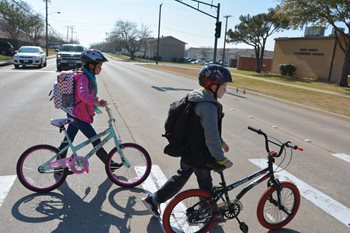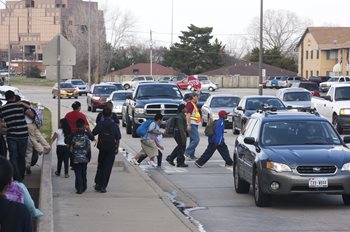Safe Routes to School

Dover Elementary Safe Routes to School Plan, City of Richardson (Traducción al español a continuación)
Do you live in Richardson near Dover Elementary School? We want to hear from you! NCTCOG is developing a Safe Routes to School (SRTS) plan to improve walking and biking safety for students getting to and from Dover Elementary.
We want to hear from the community around the school about your safety concerns, questions, and ideas.
Based on a thorough analysis of crash reports in the area, speeds on nearby roads, walking conditions, and feedback from parents, teachers, and community members, NCTCOG will develop a report including recommendations for infrastructure improvements (such as sidewalks and safe road crossings) to make the area safer for children. The report will also include recommendations to improve education and outreach about safety issues.
If you have a child currently attending Dover Elementary School, please complete this very brief two-question survey.
If you have any questions or ideas, please email Devia Joshi at djoshi@nctcog.org
Plan Escolar sobre las Rutas Seguras de la Escuela Primaria Dover, Ciudad de Richardson
¿Vives en Richardson, cerca de la Escuela Primaria Dover? ¡Queremos escucharte! NCTCOG está desarrollando un plan de Rutas Seguras a la Escuela (SRTS por sus siglas en inglés) para mejorar la seguridad para los estudiantes que caminan y para los que se van en bicicleta hacia y desde la escuela primaria Dover.
Nos interesa escuchar de la comunidad en los alrededores de la escuela sobre las preocupaciones, preguntas y las ideas de seguridad.
Según el análisis de informes sobre colisiones en la zona, la velocidad en las carreteras cercanas, las condiciones para caminar y las aportaciones de los padres de familia, maestros y miembros comunitarios, NCTCOG elaborará un informe que incluya recomendaciones para mejorar las infraestructuras (como las banquetas y cruces viales seguros) para poder hacer la zona segura para los niños. El informe también incluirá recomendaciones para mejorar la educación y la divulgación sobre las cuestiones de seguridad.
Si actualmente tienes un hijo(a) en la Escuela Primaria Dover, te pedimos que completes esta breve encuesta de dos preguntas.
Si tienes alguna pregunta o ideas, envía un correo electrónico a Devia Joshi en djoshi@nctcog.org
 |
 |
| All photos courtesy of NCTCOG |
NCTCOG's Safe Routes to School Program
NCTCOG's Safe Routes to School (SRTS) program is focused on encouraging and enabling more children to safely walk and bicycle to school, thereby improving student health, traffic congestion, safety, and air quality around schools. NCTCOG supports SRTS with funding, encouragement, education, and planning. Check out our brochure for more information (also available in Spanish).
For information about school siting in the region, see School Site Planning & Access web page.
- The percentage of students that walk or bicycle to school has dropped from a national average of 48 percent in 1969 to just 13 percent in 2009, and to 10 percent in 2017.1,2
- Vehicle trips to K-12 schools account for 10 to 14 percent of traffic during the morning commute.1
- SRTS engineering, education, and encouragement interventions have been shown to decrease pedestrian injury rates by 44 percent, and increase walking and biking rates by 25 percent.3, 4
- If 100 children at one school walked or bicycled instead of being driven every day for one school year, they would keep nearly 35,000 pounds of pollutants out of the air.5
School Crossing Guard Regional Guidance
School crossing guard establishment and management can be a difficult and complicated issue for many jurisdictions and school districts. How can crossing guards be best established and managed in a way that helps ensure the safety of school-aged children crossing busy roadways? The Sustainable Development team is investigating the challenges faced and methods used regarding crossing guard placement, pay, and management in North Texas to develop regional guidance for crossing guard establishment.
To learn more about this work and activities to date, see the information presented at the September 2023 Crossing Guards Regional Issues and Needs Coordination Meeting here.
Crossing Guard Resources
Safe Routes to School Guide: Adult School Crossing Guard Guidelines
University of North Carolina Highway Safety Research Center Adult School Crossing Guard Guidelines
New Jersey Department of Transportation School Zone Design
Arizona Department of Transportation Traffic Safety for School Area Guidelines
 |
 |
NCTCOG periodically funds SRTS infrastructure projects, such as sidewalks and crosswalks, through Transportation Alternatives calls for projects. Find more information on our Call for Projects webpage.
Under the 2022 call for projects, nearly $4 million was awarded to 3 SRTS projects.
Under the 2020 call for projects, nearly $7 million was awarded to 6 SRTS projects.
Under the 2017 call for projects, $16.4 million was awarded to 22 SRTS projects.
Under the 2014 call for projects, $5.7 million was awarded to 13 SRTS projects.
These improvements will provide better access to 42 elementary and middle schools across the region. Visit the Bicycle-Pedestrian Funding Opportunities web page for more information.
2019 Safe Routes to School Regional Training
More than 60 engineers, planners, local government and school district officials attended the SRTS Regional Training hosted by NCTCOG in May 2019, led by instructors from Toole Design. The presentations and handouts from the training can be downloaded by clicking on the links below.
- Why SRTS Matters
- Gathering Information and Engineering Strategies
- SRTS Plans and SRTS Project Prioritization
- How to Make SRTS Happen
Handouts:
- Agenda
- Field Exercise - Observation of a School
- How Communities Make SRTS Happen
- SRTS Web Resources
- ActiveTrans Priority Tool (ATP)
Walk & Roll and Bike & Roll to School Days are annual events sponsored by the Safe Routes to School National Partnership to promote safe walking and bike to and from school. Bike & Roll to School Day (BRTSD) is usually held in early May, while Walk & Roll to School Day (WRTSD) is usually held in early October. For more information about Walk to School Day, see the Walk Bike & Roll to School Day web page.
In 2024, NCTCOG hosted promotions for both Bike & Roll and Walk & Roll to school days by giving away free safety-themed swag to schools that registered their events with the agency. NCTCOG also raffled off four bikes last year to create excitement and interest in walking and biking to school. At WRTSD 2024, 28 schools registered with NCTCOG and student participation at individual school events ranged from 50 to over 400 students.
Keep Walking!
Make every day Walk to School Day! Examples of ongoing activities include Walking School Buses (check out this one in Fort Worth!), and Golden Sneaker Programs. The National Walk and Bike to School Day website offers great resources that are free to download.
NCTCOG Policy Bundle Program: The policy bundle program rewards cities, counties, ISDs, and transit agencies for adopting policies that support the Mobility 2045 plan. When policies are adopted and approved by NCTCOG through this process, Transportation Development Credits (TDCs) are awarded which can be used in place of the required local match for federal funding. Previous rounds of policy bundle awards have included polices on school siting coordination between cities/counties and ISDs. More information on the program, as well as a form to request an application after the next round opens, is available here.
Joint-Use Agreements: Joint Use Agreements are formal agreements usually between two separate government entities, such as a school and city to share public property or facilities. These agreements can save money for each entity and ensure that existing facilities and property are used to their fullest extent by the communities they serve. For more information and examples of Joint-Use Agreements, visit the Joint-Use Agreements webpage.
School District-Transit Report: School District - Public Transit Coordination in the Dallas-Fort Worth Region Report (2020)
This report investigates current partnerships and future coordination opportunities between public transportation agencies and ISDs. Joint coordination with transit agencies can save ISDs money on transportation costs and optimize the efficiency of transit routes to serve the most people possible.
School Curriculum (free)
Go to LookOutTexans.org to download a free School Kit for teaching 3rd - 8th grades about pedestrian and bicycle safety. The School Kits were created with input from North Texas educators, and were designed to support the Texas Essential Knowledge and Skills (TEKS) standards for physical and health education.
Additional parent and teacher resources are available for download:
| School Zone Safety Tips (Spanish) |
NCTCOG has a history of helping local communities plan for SRTS. Below are just a few of the examples.
- Safe Routes to School Action Plan for Webb Elementary (Arlington) (2019)
- Safe Routes to School Action Plan for Arturo Salazar Elementary, Leila P. Cowart Elementary, and L.V. Stockard Middle School (Dallas) (2019)
- Walking Safety Assessment for Speer Elementary (Arlington) (2019)
- Kennedale – Delaney Elementary and Arthur Intermediate Safe Routes to School Plan (2017)
- Fort Worth – Applied Learning Academy Safe Routes to School Plan (2017)
- Fort Worth – Blue Zones City-wide Safe Routes to School Planning – Prioritization Criteria (2015)
Local Examples
Staff Contact: Shawn Conrad
Footnotes
1. National Center for Safe Routes to School. (2011). How children get to school: School travel patterns from 1969 to 2009.
2. Federal Highway Administration. (2019). Children's Travel to School: 2017 National Household Travel Survey
3. Di Maggio & Guohua. (2013). Effectiveness of a safe routes to school program in preventing school-aged pedestrian injury. Pediatrics. 131(2), 290-296.
4. McDonald et. al. (2014). Impact of the safe routes to school program on walking and bicycling. Journal of the American Planning Association, 80(2), 153-167.
5. National Center for Safe Routes to School Task Force. (2008). Safe Routes to School: A Transportation Legacy - A National Strategy to Increase Safety and Physical Activity among American Youth.
